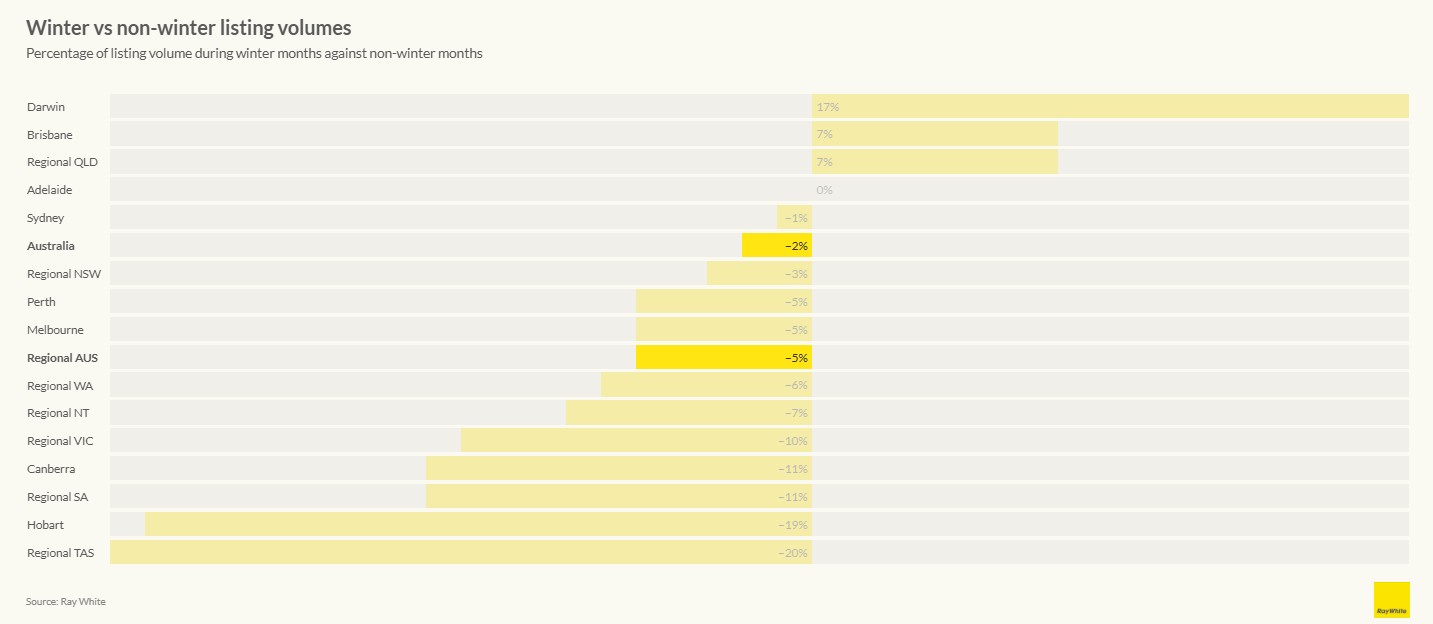Australian property listings drop with winter temperatures as homeowners escape to warmer destinations. This seasonal market slowdown creates unique challenges and opportunities for buyers and sellers alike.
Methodology: how we tracked the winter property exodus
This analysis draws from Ray White’s comprehensive internal database that monitors every property listing across Australia. Our dataset captures both Ray White listings and those from competitors, providing a complete picture of market activity across all capital cities and regional areas from 2022 through early 2025.
To identify seasonal patterns, we compared average listing volumes during winter months (June and July) against non-winter periods across multiple years. We then calculated percentage differences to quantify the winter effect for each region.
The geographical breakdown allowed us to isolate regional variations and identify which areas experience the most significant winter declines versus those that maintain activity or even see increases during the cooler months.
The great winter escape by the numbers
As temperatures fall during June and July, so too do the number of homes hitting the market. Nationwide, winter listings average 39,895 properties – nearly two per cent lower than non-winter months. But this national figure masks some dramatic regional variations that tell a more interesting story.
The transition into winter is particularly stark. When May gives way to June, Australia sees an average 7 per cent plunge in property listings. It’s almost as if you can hear the collective sound of “For Sale” signs being postponed in favour of passport stamps.

The geography of winter real estate hibernation
Not all regions feel the winter property blues equally. Some areas see real estate activity slow down dramatically, while others barely notice a change.
The winter hibernators
Leading the pack in winter market hibernation:
- Regional Tasmania: In winter, there are 20 per cent fewer listings – as one of the coldest parts of Australia, Tasmanians know when it’s time to escape their island for warmer shores.
- Hobart: Not far behind with a 19 per cent winter decline. The city’s residents are only slightly less likely to sell than their regional counterparts.
- Regional South Australia: Coming in third with an 11 per cent winter slowdown. When the famous South Australian wineries get too chilly to enjoy, residents appear to postpone their property decisions.
- Canberra: The nation’s capital shows a 10.7 per cent winter dip – likely a combination of the notoriously frigid Canberra winters and the political class’s annual migration to warmer climes during parliamentary breaks.
- Regional Victoria: Rounds out the top five with a 10.3 per cent decline. Those picturesque Victorian countryside properties apparently look less appealing when photographed under grey winter skies.
The pattern is clear: the colder your region, the more likely your real estate market takes a winter vacation.
Swimming against the tide: Australia’s winter warriors
While much of the country retreats from the property market during winter, some regions actually heat up:
- Darwin: Defies the national trend with a remarkable 17.4 per cent increase in winter listings. Perhaps the perfect dry season weather makes it the ideal time to show off properties in the Top End.
- Brisbane and Regional Queensland: Both show around 7 per cent more listings during winter. With their mild winter climates offering a respite from the humidity, locals appear happy to host open homes rather than join the exodus south.
City slickers vs country folk: who escapes more?
Interestingly, regional areas collectively show a greater winter decline (-4.67 per cent) than capital cities (-1.75 per cent). This suggests rural property owners are either more sensitive to seasonal changes or perhaps have more freedom to travel during winter months.
For winter buyers, this seasonal pattern creates a distinct dynamic. With fewer properties on the market and less competition at inspections, those willing to brave the cold often find themselves in a stronger negotiating position. The winter property market may be hibernating, but for the strategic buyer, it might just be the perfect hunting season.
